The J201 is an N-channel JFET transistor known for its versatility in general-purpose applications, especially in circuits involving low-level audio and high-impedance signal sources. This component's distinct characteristics make it well-suited for a range of electronic applications, ensuring signal integrity and minimizing noise for optimal performance.
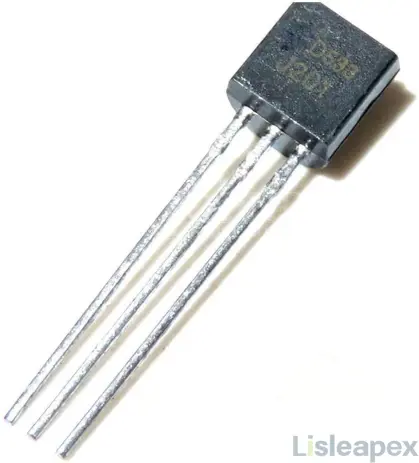
For more details about the J201, including its pinout, datasheet, equivalents, and additional information, feel free to inquire with us. We welcome your RFQ and are ready to provide the necessary details for your electronic component needs.
What is J201 Transistor
The J201 is an N-channel junction field effect transistor (JFET) that is widely used in electronic circuits. Key features include versatility for low-level audio amplification and high-impedance signal sources, as well as superior performance in maintaining signal integrity and achieving low-noise operation.
The J201's pins include a Drain, Source, and Gate, which are connected to a higher voltage, lower voltage, or ground in a circuit, and a Gate, which controls the conductance between the Drain and Source, respectively. In electronic circuits, the J201 can be used in applications requiring precise signal processing, especially in audio amplification and high-impedance signal processing, balancing signal integrity and low-noise operation.
J201 Pinout and Pin Configuration
The J201 is a Junction Field Effect Transistor (JFET) commonly used in electronic circuits.
Here’s the diagram,

Pin configuration
|
Pin Number |
Pin Name |
Description |
|
1 |
Gate |
The gate terminal is responsible for triggering the device. |
|
2 |
Source |
Current flows out from the JFET through the source terminal. |
|
3 |
Drain |
The drain terminal serves as the current inlet for the JFET device. |
- Drain: This is the pin connected to the higher voltage in the circuit.
- Source: This is the pin connected to the lower voltage or ground.
- Gate: This is the control pin that determines the conductivity between the Drain and Source terminals. The voltage applied to the Gate controls the flow of current between Drain and Source.
Specifications of J201
|
Parameter |
Value |
|
Type |
N-Channel |
|
Mounting Type |
Through Hole |
|
Package / Case |
TO-226-3, TO-92-3 (TO-226AA) |
|
Supplier Device Package |
TO-92-3 |
|
Operating Temperature |
-55°C~150°C TJ |
|
Packaging |
Bulk |
|
Part Status |
Obsolete |
|
Moisture Sensitivity Level (MSL) |
1 (Unlimited) |
|
Power - Max |
625mW |
|
Current - Drain (Idss) @ Vds (Vgs=0) |
200μA @ 20V |
|
Voltage - Cutoff (VGS off) @ Id |
300mV @ 10nA |
|
Voltage - Breakdown (V(BR)GSS) |
40V |
Features of J201
Here are the features and technical specifications for the J201 JFET,
J201 Features / Technical Specifications:
- Type Designator: J201
- Type of Transistor: JFET (Junction Field-Effect Transistor)
- Type of Control Channel: N-Channel
- Package: TO-92
- Low Cutoff Voltage
- High Input Impedance
- Very Low Noise
Electrical Characteristics:
- Max Voltage Applied From Gate to Source: -40V
- Max Drain to Gate Voltage: 40V
- Max Continuous Gate Current: 50mA
- Gate to Source Cutoff Voltage (Min to Max): -0.3V to -1.5V
- Max Power Dissipation: 350mW
Temperature Range:
- Operating Temperature Range: -55°C to +150°C
- Storage Temperature Range: -55°C to +150°C
Additional Features:
- Very Low Noise & High Gain
Where to Use J201 JFET
The J201 N-channel JFET transistor is commonly used in electronic circuits requiring low-level audio amplification, high-impedance signal processing, and general-purpose signal amplification. Its versatility and high input impedance make it suitable for a variety of applications, including preamplifiers, signal switching in audio systems, and experimentation in electronics labs.
How to Use J201 JFET
To utilize the J201 N-channel JFET transistor in electronic circuits, ensure correct pin identification, connect the Drain to a higher voltage and the Source to a lower voltage, apply a control voltage to the Gate for conductivity regulation, bias the JFET appropriately, connect input and output signals as needed, and experiment with circuit components for optimization. Refer to the datasheet for specific details and adhere to manufacturer guidelines to achieve desired circuit functionality.
How to Safely Long Run in a Circuit
To ensure long-term reliable performance of the J201 FET transistor, avoid driving loads exceeding 50mA, refrain from increasing the gate-to-source voltage beyond -40V, and the drain-to-gate voltage beyond 40V. Additionally, store and operate the transistor within a temperature range above -55 degrees Celsius and below +150 degrees Celsius. Adhering to these specifications will contribute to the stable and durable operation of the transistor over an extended period.
Advantages and Disadvantages of J201
Understanding these advantages and disadvantages helps in making informed decisions when choosing for specific applications.
Advantages of J201:
- Low Noise: J201 transistors are known for their low noise characteristics, making them suitable for applications where minimizing signal distortion is crucial, such as in audio circuits.
- High Gain: They offer high voltage gain, making them effective in amplifying weak signals. This property is valuable in applications where signal amplification is required.
- Versatility: J201 transistors are versatile and find applications in various electronic circuits, including audio amplifiers, preamplifiers, and signal processing circuits.
- Widely Used: Being a commonly used transistor, J201 is widely available, making it convenient for electronics enthusiasts and professionals to source for their projects.
Disadvantages of J201:
- Limited Availability: While J201 transistors are commonly used, there might be instances where their availability is limited, especially in comparison to more ubiquitous transistors.
- Cost: Depending on availability and demand, J201 transistors may be relatively more expensive than some other alternatives, impacting the overall cost of a project.
- Sensitivity to Static Electricity: Like many field-effect transistors (FETs), J201 is sensitive to static electricity. Adequate precautions should be taken during handling to prevent damage.
- Variability: There can be variability between individual J201 transistors, and this may affect performance consistency. It's advisable to select transistors with similar characteristics for critical applications.
J201 Application
High-Gain, Low-Noise Amplifiers
The J201 is commonly employed in high-gain amplifiers where low noise is critical for maintaining signal fidelity.
Low-Current, Low-Voltage Battery-Powered Amplifiers
Its suitability for low-current and low-voltage applications makes the J201 ideal for battery-powered amplifiers, extending battery life.
Infrared Detector Amplifiers
In circuits detecting infrared signals, the J201 can be utilized for amplifying weak infrared signals with minimal noise interference.
Ultra-High Input Applications: Sensor Circuits
J201 finds application in sensor circuits requiring ultra-high input impedance, ensuring accurate and sensitive signal processing.
Audio Preamp Circuits
Due to its high input impedance and low noise, the J201 is commonly integrated into audio preamp circuits, enhancing the quality of audio signals.
Audio Amplifier Stages
Amplification stages in audio systems benefit from the J201's high gain, contributing to the overall amplification of audio signals.
Laser Detection & Data Amplifications
In laser detection applications, the J201 can be used for amplifying signals related to laser detection and data amplifications.
Infrared Detection & Data Amplifications
For circuits involved in infrared detection and data amplification, the J201's characteristics make it suitable for processing and enhancing infrared signals.
J201 Package
The J201 JFET is housed in a TO-92 package, a widely utilized package in general-purpose electronic devices, particularly those designed for low-power applications.
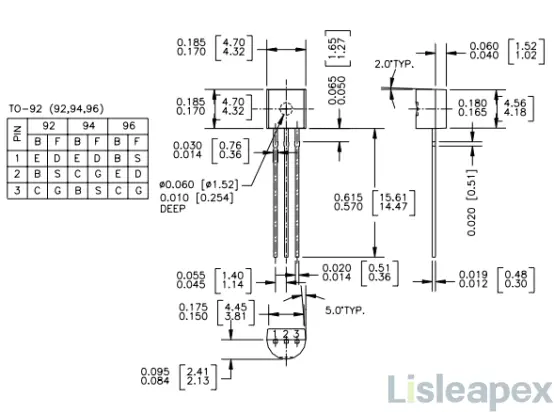
The TO-92 package is constructed from epoxy material, known for its optimal thermal capacity and lightweight characteristics. This ensures efficient heat dissipation and contributes to the overall compactness of the device.
Given the J201 JFET's prevalence in smaller-scale applications, the TO-92 package proves to be the most fitting choice. Its design aligns with the requirements of miniature electronic circuits, providing a balance between thermal efficiency and lightweight construction.
CAD Model of J201
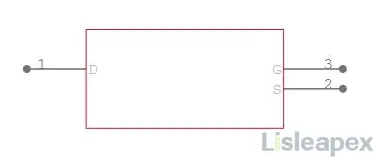
Symbol

Footprint
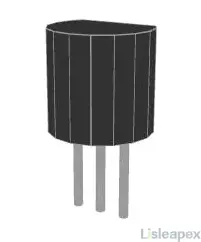
3D Model
Characteristics Curves of J201 JFET
#1 Output characteristics
The graphs illustrate the output characteristics of the J201 JFET, depicting the correlation between drain current and drain-to-source voltage.
Maintaining a consistent cutoff voltage, variations in the gate-to-source voltage lead to a proportional increase in drain current. The drain current experiences gradual augmentation, attains saturation, and ultimately demonstrates an asymptotic behavior.
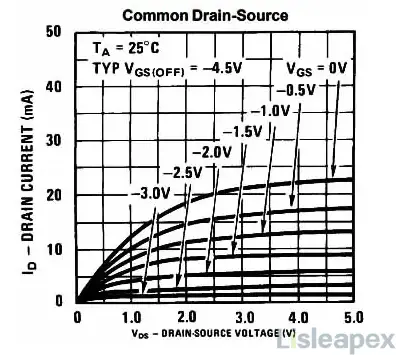
#2 Transfer characteristics
The diagram illustrates the transfer characteristics of the J201 JFET, portraying the relationship between drain current and gate-to-source voltage.
Maintaining constant drain-to-source voltage values while varying gate-to-source cutoff voltages, the graph reveals a decrease in drain current, reaching negative values in relation to the gate-to-source voltage.
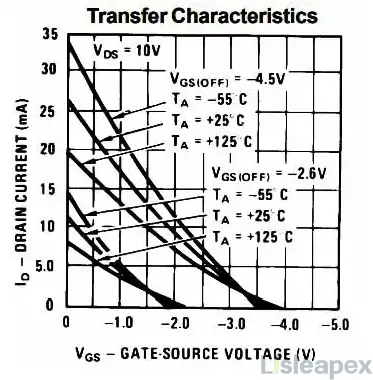
J201 Equivalent & Replacement
The J201 transistor has several equivalents that can be used as replacements in electronic circuits. Check as followings,
2SJ201:
The 2SJ201 is functionally equivalent to the J201 transistor, known for its low noise characteristics, making it suitable for various audio applications. Verify pin configuration for proper compatibility.
LJ2015-52:
The LJ2015-52 is a direct substitute for the J201, offering a high voltage rating. Ensure pin compatibility, and note that it may have a slightly higher on-state resistance.
MMBFJ201:
The MMBFJ201 is interchangeable with the J201 and is characterized by low leakage current. Confirm pin configuration for compatibility, and be aware of a slight reduction in gain compared to J201.
CJ201NL:
The CJ201NL serves as a cost-effective alternative to the J201.
If you are searching for the 2NXXXX Parts, check the table below,
|
Transistor |
Parameters |
Advantages |
Disadvantages |
|
2N4338 |
High gain, low noise |
Suitable for audio, high gain, low noise |
Limited availability |
|
2N4339 |
Low noise, good high-frequency response |
Good high-frequency response, low noise |
Limited availability |
|
2N4340 |
High gain, low noise |
High gain, low noise |
Limited availability |
|
2N4341 |
Low noise, suitable for audio applications |
Suitable for audio, low noise |
Limited availability |
|
2N5458 |
High gain, low noise |
High gain, low noise |
May have higher on-state resistance |
|
2N5459 |
High gain, low noise |
High gain, low noise |
May have higher on-state resistance |
|
2N5457 |
High gain, low noise |
High gain, low noise |
May have higher on-state resistance |
|
NTE458 |
Cost-effective, can replace J201 |
Cost-effective, versatile replacement for J201 |
Performance may vary between manufacturers |
SMD Equivalent of J201 JFET
The surface-mount device (SMD) equivalent of the J201 JFET is the MMBFJ201, which is packaged in the SOT-23 format.
The MMBFJ201 SMD component serves as a direct replacement for the traditional J201 JFET, offering compatibility in a compact SOT-23 package. This SMD version facilitates easy integration into modern circuit designs, particularly those requiring surface-mount technology. The MMBFJ201 preserves the essential characteristics of the J201, making it a suitable choice for applications where SMD components are preferred for their compactness and versatility.
J201 vs 2N5457: How to Choose
The J201 and 2N5457 are both general-purpose junction field-effect transistors (JFETs) commonly employed in distortion pedals and buffer stages within electronic circuits. While the 2N5457 is often utilized as a substitute for the J201, there are notable distinctions between them. The 2N5457 is recognized for its application in scenarios requiring lower maximum gain yet delivering a brighter top end. Both devices employ junction FET technology, but the 2N5457 boasts a voltage rating of 25V and comes packaged in TO-92, distinguishing it from the J201, which is available in both TO-92 and SOT-23 packages.
The J201, serving as a low-voltage emulator of a vacuum tube, has found extensive use in amplifier emulation circuits. On the other hand, the 2N5457 is designed for general-purpose switching and amplification applications, featuring high gain, low noise, and low power operation. Its widespread application extends to audio equipment for tasks such as amplification, tone modulation, and various audio signal processing purposes. These nuanced differences make each transistor suitable for specific contexts, depending on the desired performance characteristics and intended applications within electronic circuits.
J201 JFET Transistor Manufacturer
The J201 is a Junction Field-Effect Transistor (JFET), and it is produced by various semiconductor manufacturers. Here are the main manufacturers,
Fairchild Semiconductor (Now Part of ON Semiconductor):
- Background: Fairchild Semiconductor was a pioneering company in the semiconductor industry, founded in 1957. It played a crucial role in the development of integrated circuits and transistors.
- Acquisition by ON Semiconductor: In 2016, Fairchild Semiconductor was acquired by ON Semiconductor. This acquisition strengthened ON Semiconductor's portfolio and market presence in power management and analog semiconductor solutions.
Vishay Intertechnology:
- Background: Vishay Intertechnology is a global manufacturer of a wide range of electronic components, including discrete semiconductors, passive components, and integrated circuits.
- Product Range: Vishay's product portfolio covers resistors, capacitors, inductors, diodes, transistors, optoelectronics, and more. They are known for providing components for various applications in electronics.
ON Semiconductor:
- Background: ON Semiconductor is a leading supplier of semiconductor-based solutions. The company was originally a spin-off from Motorola's semiconductor division in 1999 and has since grown to become a major player in the industry.
- Product Focus: ON Semiconductor provides a wide range of products including power management ICs, analog and digital ICs, discrete semiconductors, and more. The acquisition of Fairchild Semiconductor expanded ON Semiconductor's capabilities in power management and analog solutions.
Central Semiconductor Corp.:
- Background: Central Semiconductor Corp. is a manufacturer of discrete semiconductors, including diodes and transistors. The company has been in operation for several decades and is known for its focus on high-quality semiconductor components.
- Product Range: Central Semiconductor offers a variety of discrete semiconductors such as bipolar transistors, MOSFETs, rectifiers, and other components commonly used in electronic circuits.
J201 Datasheet PDF
Download datasheet PDF of J201 from here>>
FAQ
-
Can the J201 be used in high-frequency applications?
It is not optimized for high-frequency applications. It is more commonly used in audio-frequency circuits.
-
What is the typical voltage range for the J201?
It is commonly used with low voltage levels. It is suitable for circuits where the voltage levels are compatible with its specifications.
-
Is the J201 suitable for switching applications?
While it is primarily designed for amplification purposes, it can be used in simple switching applications where low-frequency signals are involved.
-
What are the key characteristics of the J201?
It typically features low noise, high input impedance, and good linearity. These characteristics make it suitable for audio amplification and signal processing.
-
What is the type of JFET is the J201?
It is an N-channel JFET. In the JFET family, N-channel devices are known for their ability to amplify signals with negative voltage swings.
Stay updated with Lisleapex by signing up for the newsletter


 Congratulations On Your Successful Submission
Congratulations On Your Successful Submission
 Submission Failure
Submission Failure